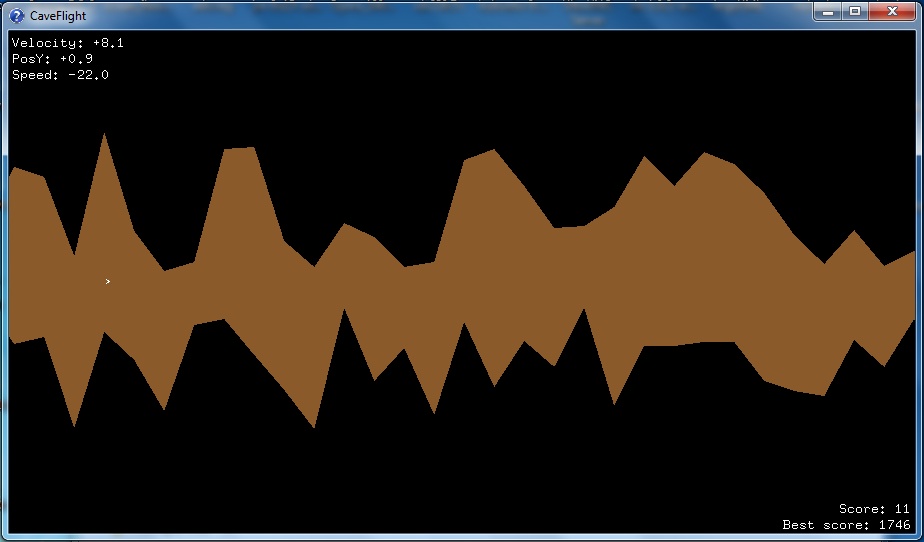A Simple flight simulator in a randomly generated environment.
Written in Assembly, utilizes OpenGL.
Esc - Ends the game
P - Pauses the game
SpaceBar - Accelerates upwards
Write a simple game in the assembly language with a help of win32api and OpenGL libraries. You have nasmGL.exe (modified to allow usage of real constants) to your disposal.
Game CaveFlight takes place in a randomly generated cave environment. Gravity of 1g pulls the ship naturally downwards. Spacebar affects the movement in the opposite direction with acceleration of -2g. For the sake of simplicity we will add these two accelerations together and as such only need to deal with -1g when accelerating upwards.
Cave, ship, text outputs (score, velocity) and everything else is rendered by OpenGL.
Collisions are handled in OpenGL using a stencil buffer technique (more details further below).
- kernel32.dll - functions that allow working with kernel such as
ExitProcess(),Sleep(), etc. - user32.dll - win32api, creation of the window, handling of the window, etc.
- advapi32.dll - extended api functions, also used for generating random numbers
- gdi32.dll -
ChoosePixelFormat(),SetPixelFormat() - opengl32.dll -
glOrtho()for mapping of the window boundaries - glut32.dll - drawing of text,
glutBitmapCharacter() - msvcrt.dll - standard C functions,
sprintf() - winmm.dll -
timeGetTime()function to return system time, basis for movement in the game
Frames per second (fps) is what's utilized as the basis for movment in the game.
By calling timeGetTime() in every frame and by comparing that acquired value with the time acquired in the previous frame we can calculate the time delta that's then used to calculate movement of objects.
; calculating time between two frames
invoke timeGetTime ; fills eax with itme in ms
mov [dwCurMoveTime], eax
fild dword [dwCurMoveTime]
fisub dword [dwLastMoveTime]
fmul dword [dwTimeFactor] ; converts time from ms to s
fstp dword [dwTimeSpan]
mov eax, dword [dwCurMoveTime]
mov [dwLastMoveTime], eax
Handling of collisions is implemented using OpenGL and as such doesn't require complex geometric calculations that would otherwise take up considerably more CPU power. The actual implementation is achieved by drawing relevant objects in the stencil buffer and by reading of the stencil buffer around the ship to detect collisions.
invoke glClearStencil, 1 ; set stencil buffer to 1
; draw the inside of a cave (-1)
invoke glStencilFunc, GL_ALWAYS, 1, 3
invoke glStencilOp, GL_KEEP, GL_KEEP, GL_DECR
; draw the ship (+1)
invoke glStencilFunc, GL_ALWAYS, 1, 3
invoke glStencilOp, GL_KEEP, GL_KEEP, GL_INCR
Doing the above results in solid objects being represented by 1, free space by 0 and collisions by 2 in OpenGL's stencil buffer.
By calling glReadPixels() around the ship we can efficiently check for any 2 occurrences in the stencil buffer to detect a collision.
When a collision happens the code then calls InitGame to reset the game.
The game can be further enhanced with various graphical textures and by adding more objects to the environment. Adding more objects should be relatively simple because as long as they are also added to the stencil buffer they will automatically become collidable.
